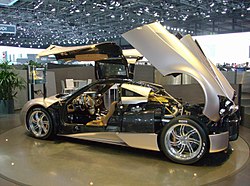The Pagani Huayra (pronounced: wai-rah) is an Italian mid-engined sports carproduced by Pagani. Succeeding the company's previous offering, the Zonda, it will cost £849,000[1] ($1,300,000). It is named after Huayra-tata, which means "God of the winds" in Quechua, the official language of the Inca Empire.[2][3] The Huayra was named "The Hypercar of the Year 2012" by Top Gear magazine and received a very positive review when tested by Richard Hammond on Top Gear. The Huayra is currently the fastest road-legal and streetworthy car ever to go round the Top Gear Test Track, setting a time of 1 minute 13.8 seconds on street legal, Zonda R-derived Trofeo tires.
Contents[hide] |
[edit]Performance
The Huayra uses a twin-turbo Mercedes-AMG 60° V-12 engine.[3] The Huayra's 6.0-litre engine, the M158, produces 730 metric horsepower (720 bhp)(539 kW) and 1,000 N·m (740 lb·ft) of torque. Its top speed is about 231 mph (372 km/h) [1]and it has a 0–60 miles per hour (0–97 km/h) time of 3.3 seconds.[1] Using Pirellitires, the Pagani Huayra is capable of withstanding 1.66 g of lateral acceleration at speeds of up to 230 mph (370 km/h).[3][4]
The Pagani Huayra uses a seven-speed sequential gearbox and a single disc clutch.[3] The choice not to use a dual-clutch in oil bath was because it would lead to an increase in weight of over 70 kg (154 lb), negating the advantage of the ability of such transmissions to change gears faster.[3] As a result, the entire transmission of the Pagani Huayra weighs 96 kg (210 lb).[3]
The car is equipped with bespoke Brembo brake calipers, rotors and pads. The calipers are 6-piston in front and 4-piston in the rear. The rotors are drilled carbon ceramic, 380 mm (15.0 in) in diameter and 34 mm (1.3 in) thick.[5] There are also four independent flaps which can act as air brakes or produce downforce.[6]
[edit]Engine
Mercedes-Benz's AMG division provides the engine of the Huayra. The 5,980 cc, twin-turbo, 60° AMG M158 V12, has been designed at the request of Pagani to reduce turbo lag and improve response, realized with smaller turbos, a different intercooler configuration and re-programmed ECU settings.
Like many high-performance cars, the Huayra uses dry sump lubrication. This has several key benefits including guaranteeing oil flow even when the car is subjected to extreme lateral acceleration, preventing "oil surge" which allows the engine to operate more efficiently while the lack of an oil pan allows the engine mounted lower, lowering the car's center of gravity and improving handling. The fuel consumption of the Huayra is 10 mpg in city and 14 mpg in highway (EPA testing).
A water / oil heat exchanger reduces engine warm-up times on cold days and helps maintain a stable temperature for refrigerant and lubricant.
To minimize the use of pipes and fittings (and the overall weight of the vehicle), the expansion tank is mounted directly on the engine. Intercooler fins act as an expansion tank circuit at low temperatures.
The titanium exhaust system was designed and built by MHG-Fahrzeugtechnik.[4] Hydroformed joints were developed to reduce back pressure and ensure a free flow exhaust. Titanium reduces the weight of the exhaust system while the Inconel silencers improve reliability in the most exposed parts of the exhaust at high temperatures. The entire system weighs less than 10 kg (22 lb).
[edit]Chassis
The Huayra uses a carbotanium monocoque construction.[3] The advanced composite materials used in the Huayra were first employed in the Zonda R.[3] The car features gull-wing doors.[3] The fuel tank, made of ballistic components, is positioned behind the driver.[3]
[edit]Aerodynamics
The Pagani Huayra is different from its predecessor in that it incorporates active aerodynamics.[3] It is capable of changing the height of the front from the ground and independently operating four flaps placed at the rear and front of the car.[3] The behavior of the flaps is managed by a dedicated control unit that is fed information from systems such as the ABS and ECU, which pass on information about the car's speed, yaw rate, lateral acceleration, steering angle and throttle position.[7] This is intended to achieve minimal drag coefficientor maximum downforce depending on the situation.[3] The Huayra's designer Horacio Pagani states that it has a variable drag coefficient of between .31 to .37.[8] The system also prevents excess body roll in the corners by raising the "inside" flaps (i.e. the left ones in a left-handed corner and vice-versa), increasing the downforce on that side of the car. The rear flaps also act as an airbrake. Under hard braking, both the front suspension and the two rear flaps are raised to counteract weight transfer to the front wheels and keep the whole car very stable, for instance when entering a corner.[7] Air from the radiator is extracted through an arch in the bonnet at an angle that is designed not to affect the streamline around the body. The side air intakes behind the front wheels create a low pressure zone, resulting in downforce.
[edit]Official debut
The Pagani Huayra was officially debuted online with many pictures in a press release on January 25, 2011.[3][9][10] The official world debut was at the Geneva Auto Salon 2011 in March.[11]
EA secured the exclusive video game rights to the Pagani Huayra in 2011, available exclusively in Need for Speed titles in 2011, Shift 2: Unleashed and Need for Speed: The Run.[12] This license expired on 31 December 2011. In 2012 it appeared in Need For Speed: Most Wanted at second place on the most wanted list. The Pagani Huayra also appears in the Jalopnik January DLC Car Pack forForza Motorsport 4 along with other cars like the Ford Pinto, the Alfa Romeo Montreal and seven others. While all other cars in the pack can be purchased individually the Pagani Huayra can only be obtained by purchasing the whole pack. The Pagani Huayra was also featured in Asphalt 7: Heat and in Forza Horizon Limited Edition. The Pagani Huayra is also featured in Real Racing 3.











0 comments:
Post a Comment